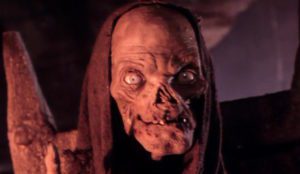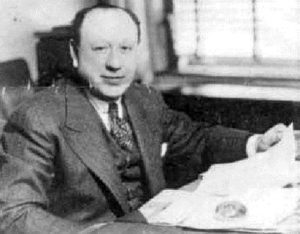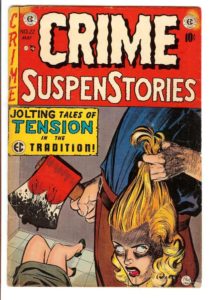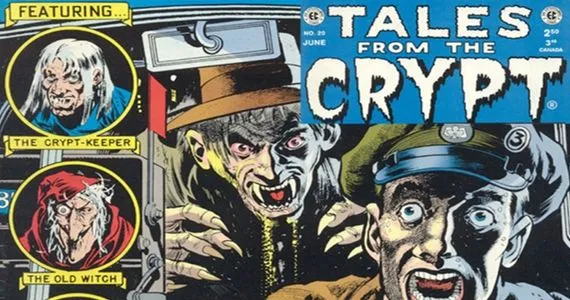AAAAAAAAAHAHAHAHAHAHAHAA!!!! Tales From The Crypt! The shriek and opening to the HBO series Tales From The Crypt still gives people chills nearly 25 years after the show went off the air. The comic books the series was based off of still give people the shivers nearly SIXTY FIVE years later. The comic book company Entertaining Comics established a legacy of the horror, crime, science fiction and morality genres that were never matched by anyone in the near 7 decades since the company bit the dust due to unfair treatment and outrageous censorship. Maxwell & William Gaines founded a legacy that still hangs true today, and this is how Tales From The Crypt and EC Comics began.

Comic books as we know it pretty much started in 1929 when Dell Publishing decided to take comics out of newspapers and give them their own separate publishing media, calling it The Funnies. In 1934, Maxwell Gaines made a greatest hits version of the best of The Funnies and called it Famous Funnies. The comic was a huge success, drawing a $30,000 monthly profit during the Great Depression, which was no small feat. In 1938, Max was a part of the group that launched All-American Comics which began the publishing of a superhero known as Green Lantern. Gaines also oversaw All-Star Comics which launched Hawkman and The Flash. Based on this success, Gaines decided to sell out his shares of All-American/All-Star and start his own publishing company, Educational Comics or EC for short, in 1944. Educational Comics, like educational anything, didn’t sell very well with the predominantly younger audience. Kids expecting The Flash or Green Lantern now were given Picture Stories From The Bible and Picture Stories From American History. Whether or not Max could have survived the non-profit generated by the educational comics will never be known as he was tragically killed in a boating accident on August 25, 1947. His 25 year old son, William (Bill for short) was thrust into the spotlight as the new boss of EC… which he wanted nothing to do with.


William F. Gaines wanted zero point zero to do with his father or his father’s business. Maxwell was considered abusive, even in those days, and even directly told Bill that he would never amount to anything. As World War II progressed, due to his un-athletic shape, Bill was rejected by the Army, Navy and Coast Guard before being drafted by the Air Force. After leaving the service, he went to New York University with plans to be a chemistry teacher. Those plans changed when his father was killed. All of a sudden, at his mother’s request, Bill was now in charge of EC comics. Knowing that the Picture Stories of whatever and Old Western comics were old and outdated, Bill had a revolutionary idea to change direction from education to entertainment.
One year after taking the reigns of EC, Gaines hired his future right hand man, Al Feldstein, as an artist. Unlike most artists at the time who drew superheroes and big tough guys, Al preferred to draw beautiful women such as Judy Garland and Lana Turner. This led to romance comics that don’t need to be mentioned apart from how they would later factor into other comics, which I’ll get to shortly. One thing that Al and Bill had in common was appreciation for old radio horror shows such as The Shadow and The Witch’s Tale. It was Feldstein himself that said they should start writing scary stories to scare the pants off the kids. Changing the name of Educational Comics to Entertaining Comics, Bill was ready to work on his new project.
In 1950, Bill unleashed an onslaught of horror on the unsuspecting United States. Bill and Al couldn’t do it alone. They would need an entire team to launch the comics they were interested in producing. Writer Harry Harrison and artist Wally Wood pitched the ideas for Weird Science and Weird Fantasy to expand into the science fiction genre. Along with Al, Bill used his own love for horror to launch three separate horror comics, each with an individual host. The Vault of Horror was launched in May of 1950 with The Vault Keeper as its host and Johnny Craig its primary artist. Tales From The Crypt, with its host The Crypt Keeper, launched in October of 1950. Some of the primary artists include Jack Davis and Bill’s left hand man, Harvey Kurtzman. The Haunt of Fear, hosted by The Old Witch (a tip of the hat to The Witch’s Tale), was also launched in October 1950 with Graham Ingels the primary artist. The hosts were added for the humor element to remind the kids that this was just fiction. Their horrible puns such as “Welcome boils and ghouls!” are still used today in one media or another.
Gaines noticed Feldstein’s preference for film noir and drawings of lovely ladies and launched Crime SuspenStories (also started in October 1950) with Johnny Craig as the primary artist again. These comics focused more on gangsters, love triangles and debauchery rather than the monsters of the horror comics. The 1946 film The Postman Always Rings Twice featured Lana Turner as the nefarious younger wife of an older business owner who plots with one of his younger employees to kill the husband and run away together. This inspired Al and his artists (including Jack Kirby) to crank out stories with a similar plot month after month. To avoid being simply horror or sci-fi, one month later Bill began Two-Fisted Tales, which featured military and war stories, with the Korean War in full effect at the time. With all these comics to write and illustrate, Bill and the crew were in a mad rush for source material literally on a daily basis since their issues were bi-monthly at the time. The gang would read everything from dime novels to watching boring television programs… anything for a spark to write about.
Sometimes they had to “borrow” some ideas from established writers. One of the most famous of these writers was none other than the premiere science fiction writer in the US, Ray Bradbury. To be blunt, Al and Bill flat out stole some of his stories to use in their Weird Science and Weird Fantasy comics. Ray eventually sent EC a letter saying he said the stories they “wrote” were awesome and, oh by the way, you guys owe me X dollars for using my stories. In classic Bill Gaines style, he wrote back along the lines of, “Ah, there you are! We were wondering how we could get in contact with you. Of course we’d like to pay you royalties and not only that, how would you like us to illustrate and adapt some more of your stories?” Just like that, Bradbury’s stories were now featured across the comic lines.

For two years, these comics swept the nation and were a smash hit, but they began to get darker and darker. The EC crew pushed the envelope by having excessive sweating, rotting corpses, buckets of blood, dismemberings, beheadings and all sorts of gruesome violence in the comics that had never been seen before. Bill’s primary storyline arcs usually involved a villain or antagonist getting his comeuppance in an ironic twist by the end of the issue. In one particular story, a gangster comes back from the dead to seek revenge, only to completely rot before completing his mission because he forgot he was dead. The artwork of Graham Ingels and his rotting corpses was top notch for those types of stories. Another famous story involves a local butcher trying to increase his profits by selling tainted meat he brought for cheap, only for it to backfire as townspeople start dying from food poisoning. When his own son dies from eating the meat, his wife hacks him up and serves his severed parts at the deli counter as the issue ends.
One of the problems Bill and the gang faced were people complaining – mostly parents but even politicians. One of the underbellies of American society in the 1950s was racism and bigotry. Bill decided to take a shot at the hypocrisy of people complaining that their comics were too violent for children yet were in favor of separate drinking fountains for white and blacks. In February of 1952, Shock SuspenStories was added to the line and were known as “preachies” for their morality and politically based storylines. One of the most famous stories involved a Jewish family moving into a predominantly Catholic neighborhood. The ringleader of an angry Christian mob did everything he could to run the family out of town. Near the end, he has their house burned down to drive them away, not realizing the family was still inside, killing all of them. Horrified, the leader’s mother revealed in front of the mob that he was half Jewish all along. The town turned on him and the leader got a taste of his own medicine.
Another famous story involves a hometown hero coming home from the Korean War, alive although missing an arm. He returns to a hero’s welcome but is angry, surly and distant from the proceedings for most of the issue. Finally at the end, he’s encouraged to give a speech and rather than thank anyone, he launches into a tirade. He screams that his best friend in the platoon he was in gave his life to save him, yet the friend won’t get a proper hero’s burial because he was black. He tells the town (and America really) to pound sand and sulks in the corner as the issue ends.
As if comics with severed heads, rotting corpses, and tales of aliens and monsters weren’t controversial enough, the “preachies” put EC over the top, a target of some of the top politicians and talking heads in the country. After all, they couldn’t spread the word of God and keep the “colored” in check if the infidels at EC comics told everyone how much they suck on a bi-monthly basis. It all came to ahead in April of 1954 when Dr. Frederic Wertham published The Seduction of The Innocent, which basically said comic books were the downfall of American children. The worst part about that hippopotamus poop is that people actually believed it.
Gaines was brought before a senate subcommittee headed by Estes Kefauver to explain himself. Gaines said that the notion that comics were responsible for the downfall of children was ludicrous but made a fatal error in placing the blame on himself, shielding his EC staff and other competitors rather than say he wasn’t the only one doing it. What this led to was the Comics Code Authority panel being introduced, which was a national team of editors responsible for deciding what can and can’t be written or illustrated. Such words as “horror” “terror” and “weird” were banned and gratuitous sex and violence would no longer be tolerated. Obviously, this new censorship was directed at one man and company, Bill Gaines and EC.
At first, Bill told everyone to go live in a tree and continued to publish his comics unchanged. Then things went south as his distributors were facing backlash when EC comics hit the newsstand. The delivery guys were literally attacked and comics were burned right in front of them. Just like that, nobody was willing to distribute the EC line of comics. Unfortunately, with no one willing to accept his comics, Bill threw in the towel in February of 1955 by cancelling most of his science fiction and horror comics before reluctantly joining the authority. His safer comics such as Tales Calculated To Drive You Mad, Panic and Incredible Science Fiction motored along until one final confrontation with the authority occurred in February 1956. Gaines decided to reprint a story first introduced in 1953 in Weird Fantasy called Judgement Day. It involved a planet of robots trying to join the Galactic Republic with a human astronaut as the mediator. The human finds out that certain robots are treated unfairly due to their different color and tells the planet that until this changes, they need to get out and stay out! At the end of the issue, the mediator takes off his helmet, revealing himself to be a black man.
Even though the story was already printed 3 years earlier, there was no internet back, then so most people had forgotten about it, not to mention it was before the Kefauver inquisition. When it was sent to the Comics Code Authority to be published in Incredible Science Fiction, the head of the authority, Judge Charles Murphy, refused to print it. Gaines called up and asked why, and Murphy said you can’t have a black man in a position of power. Furious, Bill told him that he better print the story or else he’d go to the press to raise a big stink since the Civil Rights Movement had begun a year earlier. Murphy relented but requested that the beads of sweat on the black man’s head be removed. Bill and Al, in unison, told Murphy to go sexually pleasure himself as Bill slammed the phone down. At that point, Bill saw no reason to continue to publish comics if this hypocritical nonsense was going to continue, thus ending the near 10 year run of EC Comics.
So what happened to everyone after EC Comics came to an end in 1956? Luckily, Bill had a gold mine to fall back on. Tales Calculated To Drive You Mad changed from a 10 cent comic to a 25 cent magazine simply called MAD Magazine. Harvey Kurtzman, Al Feldstein, Jack Davis and a host of other EC illustrators were brought in to continue MAD, which was now safe from the clutches of the idiotic Authority once it became a magazine. MAD was a smash satire that is still published to this day, with the most recent cover being a parody of Stranger Things. In the 1970s, two movies came out known as Tales From The Crypt and The Vault of Horror that were inspired by the comics, and selective reprints of famous issues were redistributed to the public.
In 1989, famous movie directors Robert Zemeckis (Back To The Future) and Richard Donner (Lethal Weapon) teamed up to launch Tales From The Crypt as an HBO TV series with The Crypt Keeper (looking nothing like his comic form) as the pun-spewing host, voiced brilliantly by John Kassir. The show lasted 7 years and did record numbers before it was discontinued. In 2007, Tales From The Crypt was re-launched by the company Papercutz with all original material that lasted 13 issues. The legacy of Gaines, Feldstein, EC comics and Tales From The Crypt taught people how to enjoy the weird and scary things in life, while giving the finger to bigotry, hypocrisy, censorship and racism. Tales From The Crypt and EC Comics are often imitated but never duplicated.
 PopHorror Let's Get Scared
PopHorror Let's Get Scared




